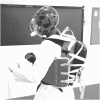Physiological responses and external validity of a new setting for taekwondo combat simulation
- PMID: 28158252
- PMCID: PMC5291476
- DOI: 10.1371/journal.pone.0171553
Physiological responses and external validity of a new setting for taekwondo combat simulation
Erratum in
-
Correction: Physiological responses and external validity of a new setting for taekwondo combat simulation.PLoS One. 2017 Jul 7;12(7):e0181298. doi: 10.1371/journal.pone.0181298. eCollection 2017. PLoS One. 2017. PMID: 28686729 Free PMC article.
Abstract
Combat simulations have served as an alternative framework to study the cardiorespiratory demands of the activity in combat sports, but this setting imposes rule-restrictions that may compromise the competitiveness of the bouts. The aim of this study was to assess the cardiorespiratory responses to a full-contact taekwondo combat simulation using a safe and externally valid competitive setting. Twelve male national level taekwondo athletes visited the laboratory on two separate occasions. On the first visit, anthropometric and running cardiopulmonary exercise assessments were performed. In the following two to seven days, participants performed a full-contact combat simulation, using a specifically designed gas analyser protector. Oxygen uptake ([Formula: see text]), heart rate (HR) and capillary blood lactate measurements ([La-]) were obtained. Time-motion analysis was performed to compare activity profile. The simulation yielded broadly comparable activity profiles to those performed in competition, a mean [Formula: see text] of 36.6 ± 3.9 ml.kg-1.min-1 (73 ± 6% [Formula: see text]) and mean HR of 177 ± 10 beats.min-1 (93 ± 5% HRPEAK). A peak [Formula: see text] of 44.8 ± 5.0 ml.kg-1.min-1 (89 ± 5% [Formula: see text]), a peak heart rate of 190 ± 13 beats.min-1 (98 ± 3% HRmax) and peak [La-] of 12.3 ± 2.9 mmol.L-1 was elicited by the bouts. Regarding time-motion analysis, combat simulation presented a similar exchange time, a shorter preparation time and a longer exchange-preparation ratio. Taekwondo combats capturing the full-contact competitive elements of a bout elicit moderate to high cardiorespiratory demands on the competitors. These data are valuable to assist preparatory strategies within the sport.
Conflict of interest statement
The authors have declared that no competing interests exist.
Figures




References
-
- Bridge CA, Jones MA, Drust B. The activity profile in international Taekwondo competition is modulated by weight category. Int J Sports Physiol Perform. 2011. September;6(3):344–57. - PubMed
MeSH terms
LinkOut - more resources
Full Text Sources
Other Literature Sources
Miscellaneous

